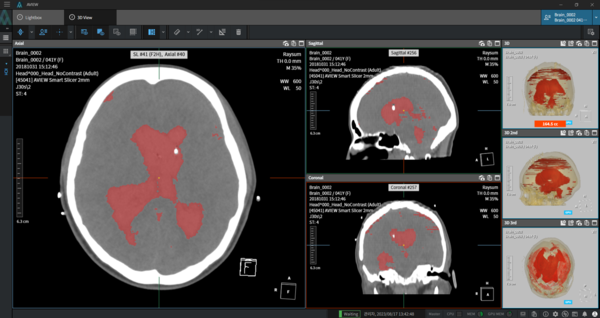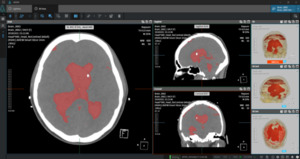Coreline Soft, a Korean medical AI company, said Thursday that the National Evidence-based Healthcare Collaborating Agency (NECA) has completed “notifying innovative medical technology use (clinical practice) results” for its AVIEW NeuroCAD, which was selected as an innovative medical technology.
Accordingly, 16 hospitals that have adopted AVIEW NeuroCAD, including Inje University Ilsan Paik Hospital, CHA University Gumi Medical Center, Chungnam National University Sejong Hospital, and the Busan Adventist Hospital, can apply the software to brain CT analysis of patients who visit their emergency room. The company can charge a certain fee to the hospital for each analysis.
“This has a significant meaning businesswise for Coreline Soft, as it allows us to extend our SaaS (Software as a Service) model to emergency rooms, where revenue is based on usage, as opposed to the traditional business model where hospitals purchase the solution,” a Coreline Soft official said.

AVIEW NeuroCAD has been recognized for its technological innovation and potential to create new markets. Last year, it was selected as an innovative medical technology through the integrated evaluation of innovative medical devices organized by the Ministry of Food and Drug Safety and the Ministry of Health and Welfare, allowing it to be used in the medical field on the basis of selective or no reimbursement.
It is brain hemorrhage brain image detection and diagnosis assistant software that supports image reading and diagnosis and treatment decisions within a limited time based on patient CT images, and its main functions include:
● Sorting patient groups from images with a lot of bleeding.
● Providing information on priority lesion areas according to the amount of bleeding.
● Previewing suspected brain hemorrhage areas to prioritize reading for emergency patients.
It can also compare 2D and 3D images and integrate with a hospital’s point-of-care system (PACS), according to Coreline Soft.
In cerebral hemorrhage, there are many reports that the amount of bleeding is closely related to the prognosis of the patient. Still, it is not widely used in the emergency department due to the difficulty and cumbersomeness of measurement.
In this situation, AVIEW NeuroCAD can automatically measure the amount of bleeding and classify the severity early on, allowing for faster treatment, such as medication and surgery. In addition, an emergency hotline can be configured in conjunction with the hospital system, and notification messages can be shared across the hospital to help medical staff respond proactively and communicate quickly.
“Cerebrovascular disease is the so-called golden time disease, which means that after a certain period after the onset of cerebrovascular disease, recovery is difficult or even fatal,” said Professor Choi Seung-pil, head of the Emergency Medicine Center at CHA University Gumi Medical Center, who introduced the product to his hospital. “We introduced AVIEW NeuroCAD for rapid diagnosis and treatment, and we will do our best to provide high-quality medical services to more patients based on this non-payment claim.”
After entering the emergency medical sector with AVIEW NeuroCAD, Coreline Soft is building a lineup of emergency medical solutions with AVIEW Aorta, confirmed as an innovative medical device last month, the company official said.
“As innovative medical technologies are allowed to enter the market first and then reevaluated afterward by further evaluating the value of dramatically improving patient lives or reducing patient cost burdens if the technology is stable enough to accumulate research results, we are preempting the emergency field with high-quality products with high barriers to entry, such as AVIEW Aorta, a cardiovascular image detection and diagnostic aid software,” the official added.
The company plans to launch a solution to measure pulmonary embolism (PE) in the third quarter of this year and coronary artery stenosis next year and will build an optimal medical imaging platform by increasing patient acceptance and diagnostic reliability.
link

